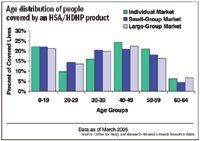State of the Industry 2006
Healthcare is an industry perhaps more complex, fragmented and difficult to comprehend than any other. When we try to understand the dynamics that make our industry such a challenge in which to work, we inevitably underestimate the impact of one force or overlook a series of other competing agendas altogether. It's a slippery slope to think we can understand it all, let alone control it.

Welcome to MANAGED HEALTHCARE EXECUTIVE's State of the Industry Report. We hope to make sense of the various "balancing acts" in our industry and to prepare you for another challenging year.

All this stabilization is favored news to financial analysts; for the first half of 2005, there was an equal mix of downgrades and upgrades among those healthcare systems assessed by Fitch Ratings, an authority on public finance. Since MHE began monitoring this metric for the State of the Industry Report back in 2000, the ratio of downgrades to upgrades has steadily improved, from a high of nearly 4-to-1 to the 1-to-1 ratio we see today. Fitch attributes this apparent stability to improved management strategies, relatively low cost of capital, and stable Medicare funding, at least in the near term. However, Fitch continues to warn of the same threats found in its report of a year ago: mounting capital needs, competition, workforce shortages, revenue constraints from entitlement programs, and rising bad debt expense, which can wipe out all the gains made by the public sector over the past five years (see chart, this page).
If the health system CEO feels guarded optimism from the stabilization of industry benchmarks, the managed care CEO is likely basking in reports that this segment continues to be strong. Indeed, while half of the rated nonprofit health systems were downgraded versus upgraded, half of the nation's HMOs are considered "financially strong," according to Weiss Ratings Inc., an independent provider of ratings for service and financial sectors. Based on data from the second quarter of 2004, the percentage of insurers receiving a Weiss rating of A (excellent) or B (good) rose to 50%, a significant increase from 1998, when only 20.8% of HMOs qualified. Of the 482 HMOs reviewed by Weiss during 2004, 65 companies were upgraded, while only three were downgraded.
Ohio’s Medicaid Work Requirement Efforts Aim to Boost Engagement, Avoid Coverage Loss
April 18th 2025Maureen Corcoran, director of the Ohio Department of Medicaid, believes the work requirement policy can be both a financial and moral effort to improve the lives of Medicaid consumers.
Read More
Conversations With Perry and Friends
April 14th 2025Perry Cohen, Pharm.D., a longtime member of the Managed Healthcare Executive editorial advisory board, is host of the Conversations with Perry and Friends podcast. His guest this episode is John Baackes, the former CEO of L.A. Care Health Plan.
Listen
Breaking Down Health Plans, HSAs, AI With Paul Fronstin of EBRI
November 19th 2024Featured in this latest episode of Tuning In to the C-Suite podcast is Paul Fronstin, director of health benefits research at EBRI, who shed light on the evolving landscape of health benefits with editors of Managed Healthcare Executive.
Listen